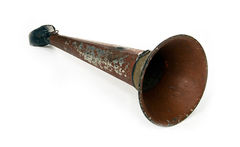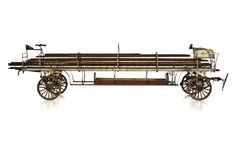THE VOLUNTEER ERA
The Colonial Period 1648–1783

RELATED ARTICLE: Post Revolution
The Dutch Settlement
Organized firefighting began as early as the Dutch settlement in New Amsterdam. In 1648, the Governor of the colony, Peter Stuyvesant, appointed four fire Wardens to help prevent fires by patrolling the colony and inspecting homes for wooden chimneys and thatched roofs. One of the first fire alarm systems was instituted in 1658 with the “rattlewatch.” The rattlewatch consisted of eight men who were charged with patrolling the town at night carrying wooden rattles that they sounded upon discovery of smoke or fire. Townspeople were expected to wake up and hurry to the location of the fire. Fires, at that time, were fought using leather buckets. Citizens of New Amsterdam were required to fill three buckets of water at sunset and place them at their doorsteps in case an alarm was sounded. At the scene of the fire, a bucket brigade was formed – one line of people passed filled buckets from the water source to the fire, and the second line passed empty buckets back to the water source to be refilled.

The first fire engines arrived in NYC in 1731 and were seen as a great improvement over the bucket brigades
Firefighting in the Colony of New York
In 1683, the British took over the colony of New Amsterdam and renamed it New York. Fire wardens were appointed to inspect chimneys and hearths, as well as to make sure each house had at least one leather bucket. If the fire wardens found anyone in violation of the city’s fire prevention ordinances, that person could be fined up to twenty shillings.
Fines were used to keep fire equipment, such as hooks, small ladders, and buckets, in good condition. The rattlewatch was still active during the British colonial period, and watchmen supplemented their rattles with bells rung at the fort and at churches. During a fire alarm, citizens were expected to throw their buckets into the street to be picked up by able bodied persons forming part of the bucket brigade. Fires were fought in this manner until hand engines were introduced.
The First Volunteer Department
The first fire engines came to New York in 1731 from Richard Newsham of London. The addition of hand-pumped and hand-drawn engines to firefighting led to the formation of volunteer companies because an organized system of people was needed that knew how to operate and maintain the pumpers. An “overseer of fire engines” was put in charge of maintaining the pumpers. Bucket brigades were still formed at fires, but were used to fill the engine's cistern, rather than to dump water onto the fire itself. In 1736, the first two fire engines in this city, initially housed in City Hall, were moved into the first firehouse on Broad Street. In December of 1737, the General Assembly of the Colony of New York passed an act to appoint no more than forty-two sober, discreet, able-bodied men as firefighters – thus, the volunteer fire department was formed and was headed by Jacob Turck.
When the Revolutionary War broke out, Jacob Stoutenburgh was “overseer of fire engines” and led seven engines and two bucket and ladders. The American army retreated from the city in September of 1776. Many firemen left as well and the city was left largely unprotected from fires. The British military tried to fight off two fires that were so disastrous the commander-in-chief ordered that no military man should interfere with fires in the city again. By the end of the war, only one fire engine in the city was left working. In February of 1786, after several years of rebuilding and reorganizing the volunteers, the city re-established the volunteers under the guise of the New York Fire Department.










